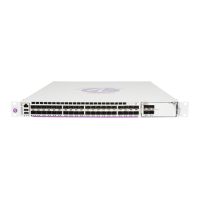SFPs
7705 SAR-A Chassis Installation Guide 99
SFP Support
See Table 6 for maximum power consumption values for the supported SFPs. Contact your
Alcatel-Lucent representative for information on SFP, SFP+, and XFP module availability
and applicability.
Bidirectional SFPs
Alcatel-Lucent supports several bidirectional SFPs. The optical interface provides single-
fiber, bidirectional connectivity operating at 1310 nm and 1490 nm wavelengths. One SFP
must be installed at the near end and the other SFP must be installed at the far end of the link.
To achieve connectivity, if the far-end SFP transmits at 1310 nm and receives at 1490 nm,
the near-end SFP must transmit at 1490 nm and receive at 1310 nm.
Installing SFPs
To install an SFP:
Step 1. Remove the SFP from the packaging and place it on an anti-static work surface.
Step 2. Hold the SFP by its sides and insert it into the appropriate port until it clicks into
place.
Step 3. For optical SFPs, remove the protective plug from the SFP port when you are ready
to attach the fiber cable.
Removing and Replacing SFPs
When you are replacing an SFP, have the following parts ready:
• a replacement SFP
• protective plugs for the SFP and a dust cover for the fiber cable connector
• an anti-static mat or electrostatic bag
Warning: Use non-ETR SFP+s only in non-ETR deployment conditions.

